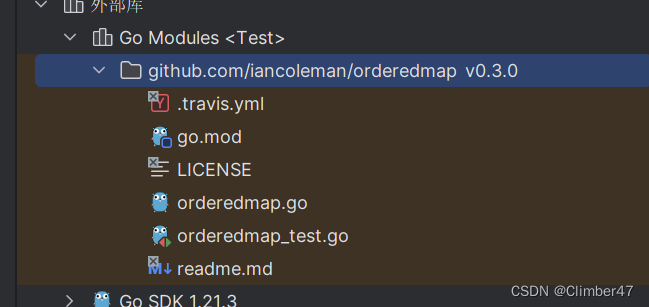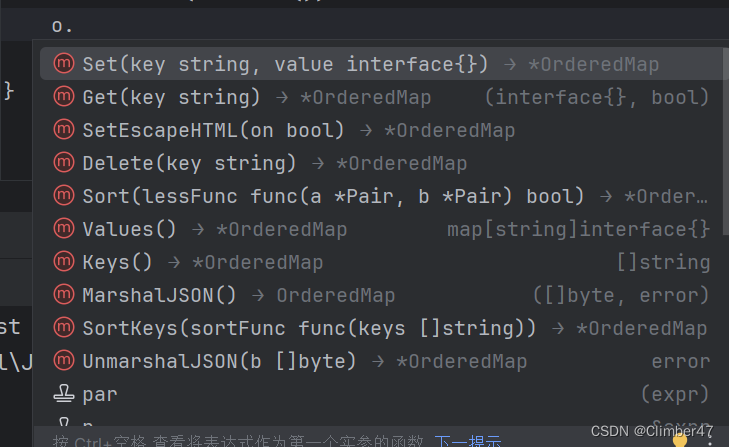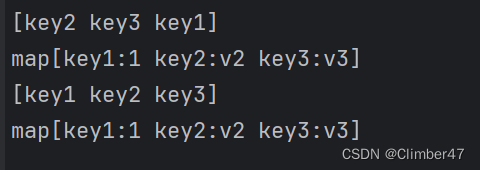前言
工作中遇到一个问题:需要导出一个MySQL表格,表格内容由sql查询得来。但现在发现,所导出的表格中,各列的顺序不确定。多次导出, 每一次的序列顺序也是不定的。
因此确定是后端,Map使用相关导致的问题。自己想法是——创一个map[int]map{}类型,即map套map。里面的map保存原有内容,int保存序号。
经网络搜索,发现已经有开源库提供了此功能,即https://github.com/iancoleman/orderedmap库。因此对他进行学习。
功能概述
Golang内置的Map是无需的,而OrderedMap则是提供了一个有顺序的Map。其顺序是插入时的顺序。
下面是官方文档中提供的功能描述:
package mainimport ("encoding/json""github.com/iancoleman/orderedmap""sort"
)func main() {// use New() instead of o := map[string]interface{}{}o := orderedmap.New()// use SetEscapeHTML() to whether escape problematic HTML characters or not, defaults is trueo.SetEscapeHTML(false)// use Set instead of o["a"] = 1o.Set("a", 1)// add some value with special characterso.Set("b", "\\.<>[]{}_-")// use Get instead of i, ok := o["a"]val, ok := o.Get("a")// use Keys instead of for k, v := range okeys := o.Keys()for _, k := range keys {v, _ := o.Get(k)}// use o.Delete instead of delete(o, key)o.Delete("a")// serialize to a json string using encoding/jsonbytes, err := json.Marshal(o)prettyBytes, err := json.MarshalIndent(o, "", " ")// deserialize a json string using encoding/json// all maps (including nested maps) will be parsed as orderedmapss := `{"a": 1}`err := json.Unmarshal([]byte(s), &o)// sort the keyso.SortKeys(sort.Strings)// sort by Pairo.Sort(func(a *orderedmap.Pair, b *orderedmap.Pair) bool {return a.Value().(float64) < b.Value().(float64)})
}其主要用法如下:
通过orderedmap.New()新建一个Map。
通过o.Set("a", 1)设置Map中的元素内容。 (注意:key必须是string)
通过o.Get("a")获取map内容。
通过keys达到for range效果。
通过o.Delete("a")进行元素删除。
通过SortKeys和Sort进行排序。
源码阅读
OrderedMap的源码,包含注释等在内,一共266行,可谓是十分简短。

其中,一共有如下的方法可使用:

OrderedMap的数据结构
New()出来的那个Map是这样:
type OrderedMap struct {keys []stringvalues map[string]interface{}escapeHTML bool
}
其中:escapeHTML是用来表示是否转义HTML字符,默认为true表示转义。可以调用SetEscapeHTML(false)方法来设置不转义HTML字符。
剩余keys是[]string,values是map。
OrderedMap有序输出的原理
做这样一个测试:
func main() {o := orderedmap.New()o.Set("key2", "v2")o.Set("key3", "v3")o.Set("key1", 1)fmt.Println(o.Keys())fmt.Println(o.Values())}其中,keys和values分别用于返回所有的key和value。
func (o *OrderedMap) Keys() []string {return o.keys
}func (o *OrderedMap) Values() map[string]interface{} {return o.values
}
输出结果为:

我们可以看到,其key是按输入顺序进行排列的切片,value是保存了对应key和value的map。
在输出时,通过定序的key,去访问不定序的value,最终输出时实现定序的效果。(定序:指与输入顺序相同)。
基础方法
初始化
通过New方法生成一个OrderedMap,其中可以通过SetEscapeHTML对该参数进行设置。
func New() *OrderedMap {o := OrderedMap{}o.keys = []string{}o.values = map[string]interface{}{}o.escapeHTML = truereturn &o
}func (o *OrderedMap) SetEscapeHTML(on bool) {o.escapeHTML = on
}
值的设置、查看及删除
通过Get获取指定key值对应的value。
通过Set对键值对进行设置。
通过Delete删除键值对。
func (o *OrderedMap) Get(key string) (interface{}, bool) {val, exists := o.values[key]return val, exists
}func (o *OrderedMap) Set(key string, value interface{}) {_, exists := o.values[key]if !exists {o.keys = append(o.keys, key)}o.values[key] = value
}func (o *OrderedMap) Delete(key string) {// check key is in use_, ok := o.values[key]if !ok {return}// remove from keysfor i, k := range o.keys {if k == key {o.keys = append(o.keys[:i], o.keys[i+1:]...)break}}// remove from valuesdelete(o.values, key)
}获取所有kv值
通过Keys()获取所有的key。
通过Values()获取所有的Value。
func (o *OrderedMap) Keys() []string {return o.keys
}func (o *OrderedMap) Values() map[string]interface{} {return o.values
}Sort和SortKeys方法
SortKeys()方法
// SortKeys Sort the map keys using your sort func
func (o *OrderedMap) SortKeys(sortFunc func(keys []string)) {sortFunc(o.keys)
}
即根据传入的方法规则,对key值进行排序。例如,按字母顺序排:
o.SortKeys(sort.Strings)
测试:
func main() {o := orderedmap.New()o.Set("key2", "v2")o.Set("key3", "v3")o.Set("key1", 1)fmt.Println(o.Keys())fmt.Println(o.Values())o.SortKeys(sort.Strings)fmt.Println(o.Keys())fmt.Println(o.Values())
}
结果:

Sort()方法
源码如下:
// Sort Sort the map using your sort func
func (o *OrderedMap) Sort(lessFunc func(a *Pair, b *Pair) bool) {pairs := make([]*Pair, len(o.keys))for i, key := range o.keys {pairs[i] = &Pair{key, o.values[key]}}sort.Sort(ByPair{pairs, lessFunc})for i, pair := range pairs {o.keys[i] = pair.key}
}其中,pair如下:
type Pair struct {key stringvalue interface{}
}
该方法内,首先通过pair保留每一个键值对。之后哦通过传入的lessFunc进行排序,再按照排序后的顺序,赋值到内部,从而实现排序。
用法示例:
// sort by Pair
o.Sort(func(a *orderedmap.Pair, b *orderedmap.Pair) bool {return a.Value().(float64) < b.Value().(float64)
})
Json相关
UnmarshalJSON方法,用于将JSON转换为有序MAP。
func (o *OrderedMap) UnmarshalJSON(b []byte) error {if o.values == nil {o.values = map[string]interface{}{}}err := json.Unmarshal(b, &o.values)if err != nil {return err}dec := json.NewDecoder(bytes.NewReader(b))if _, err = dec.Token(); err != nil { // skip '{'return err}o.keys = make([]string, 0, len(o.values))return decodeOrderedMap(dec, o)
}
MarshalJSON反之,序列化为JSON。
func (o OrderedMap) MarshalJSON() ([]byte, error) {var buf bytes.Bufferbuf.WriteByte('{')encoder := json.NewEncoder(&buf)encoder.SetEscapeHTML(o.escapeHTML)for i, k := range o.keys {if i > 0 {buf.WriteByte(',')}// add keyif err := encoder.Encode(k); err != nil {return nil, err}buf.WriteByte(':')// add valueif err := encoder.Encode(o.values[k]); err != nil {return nil, err}}buf.WriteByte('}')return buf.Bytes(), nil
}
最后还有decodeOrderedMap和decodeSlice两个方法,是辅助json转换时候所用的,在此不再阐述。
总结&心得
1、通过OrderedMap可以实现MAP的有序化,按输入顺序输出map的内容,或按自定义规则排序后进行输出。
2、使用OrderedMap会导致性能下降,不要过度依赖。
)


vueQQ邮箱注册发送验证码前端设计,如何发送验证码设计倒计时)






)







)
